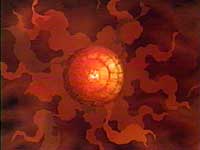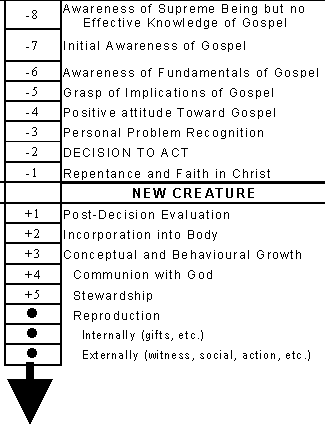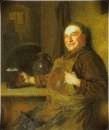The articles below were first posted early in ’07 as a three part series. Being they are some of the most viewed posts on Decompose, and are seminal to my thoughts on the subject, I’ve merged them into a single piece for your consideration.
Christianity Today added a twist to the year-end “Best of” lists with The 10 Most Redeeming Films of 2006 selections. I’ve only seen two out of the ten, but what intrigued me more than the list itself, was  how it was framed:
how it was framed:
What do we mean by “redeeming” films? They’re all stories of redemption — sometimes blatantly, sometimes less so. Several of them literally have a character that represents a redeemer; one even includes the Redeemer. With others, you might have to look a bit harder for the redemptive thread, but it’s certainly there. Some are “feel-good” movies that leave a smile on your face; some might leave you uncomfortable, even disturbed, and asking, “How should I process that?” But you won’t be able to shake it from your memory, either.
Many Christians consider this type of approach to film wishy-washy. We shouldn’t have to “look a bit harder for the redemptive thread.” In fact, the concept of a “redemptive thread” affords too much wiggle room, they say, and ultimately allows works with questionable elements (i.e., cursing, sex, violence) to skirt in under the radar. How else could Children of Men and The New World — movies without an articulate biblical message or blatantly Christian characters — be considered thematically “redemptive”?
The argument, I believe, flows out of a narrow view of Christian art. In fact, I think the term itself, “Christian art,” (really, “Christian” anything — Christian fiction / film / music / jewelry / clothing) is ambiguous, creates unnecessary expectations in the viewer / reader / consumer, and potentially reduces the role of the Christian artist to that of propagandist.
By implication, “Christian art” requires a message.
 Of course, it could said that all art contains a message, not just “Christian” stuff. The point is valid. Even as art veers into abstraction it elicits a response from the viewer. It could be revulsion or reverence, or just plain puzzlement. But artists want people to feel something. And that something could be considered the intended message.
Of course, it could said that all art contains a message, not just “Christian” stuff. The point is valid. Even as art veers into abstraction it elicits a response from the viewer. It could be revulsion or reverence, or just plain puzzlement. But artists want people to feel something. And that something could be considered the intended message.
This intended message is central to the “defenders” of “Christian art” for unless the art has a blatantly biblical message, the Christian is questioned.
For instance, Mute Math or P.O.D. aren’t considered “Christian bands” — despite being comprised of Christians — because their message is not clear enough. Likewise, authors such as Bob Liparulo or Tim Downs — who are openly believers — are not considered to be writing “Christian fiction” precisely because of the absence of a blatant biblical message. Forget that when these artists are engaged they are not hesitant to annunciate their beliefs; the fact that their “art” does not contain explicit references to those beliefs, makes it something other than “Christian.”
I just don’t get it.
Not only does the current view of “Christian art” potentially reduce the art to advertisement, it handcuffs the artist. . .at least, in their relation to the in-house critics.
When it comes to the difficulties of defining Christian art, The Lord of the Rings is a case in point. As much as Tolkien’s  epic trilogy is embraced by Christians, LotR is usually not considered Christian fiction. Wikipedia, in defining Christian literature, illustrates the sticking point:
epic trilogy is embraced by Christians, LotR is usually not considered Christian fiction. Wikipedia, in defining Christian literature, illustrates the sticking point:
Christian fiction is sometimes harder to define than Christian non-fiction. Christian themes are not always explicit. There is sometimes argument as to whether the works of a Christian author are necessarily Christian fiction. For example while there are undoubted Christian themes within The Lord of the Rings, many would not consider this to be a work of Christian fiction. . .
In the last few decades the existence of a Christian subculture, particularly in North America, has given rise to a specific genre of Christian novel, written by and for Christians and generally with explicit Christian themes. Such novels are often marketed exclusively to Christians and sold in Christian bookshops. The Christy Awards honour excellence in this genre.
Here, Christian fiction is defined as something “written by and for Christians” and characterized by its  “explicit Christian themes.” Those three earmarks — author, audience, message — serve as a barometer of contemporary Christian art. Furthermore (and maybe even more integral to the examination), is the recognition of “a Christian subculture” that “has given rise to a specific genre of Christian novel.”
“explicit Christian themes.” Those three earmarks — author, audience, message — serve as a barometer of contemporary Christian art. Furthermore (and maybe even more integral to the examination), is the recognition of “a Christian subculture” that “has given rise to a specific genre of Christian novel.”
But who is this Christian subculture and what role do they play in defining, driving — and/or policing — Christian art?
By current standards, Tolkien is only 1 of 3. He was definitely a Christian author. (In fact, J.R.R’s greatest accomplishment may, in the end, not be his fantasy trilogy, but his role in C.S. Lewis’ conversion.) Yet in regards to audience and message — two pivotal planks in the prevailing argument — he strikes out.
David Dark, in his book Everyday Apocalypse, expounds upon Tolkien’s “moral aversion” to message-driven fiction:
In his efforts to overcome the popular misreading of his work on Middle-Earth as a project in allegory, J.R.R. Tolkien expressed a distaste for the domineering quality of the allegorical while offering a helpful distinction: “I much prefer history, true or feigned, with its varied applicability to the thought and experience of readers. I think that many confuse ‘applicability’ with ‘allegory’; but the one resides in the freedom of the reader; and the other in the purposed domination of the author.”
“Purposed domination” is a wonderfully illuminating phrase in Tolkien’s explanation not only in regard to what he assures us he isn’t doing in The Lord of the Rings but also concerning a mode of creative expression to which he feels an almost moral aversion. Purposed domination, we might say, is the method of propaganda. It leaves the audience with no room for “applicability,” and the propagandist wouldn’t have it any other way. The tightly controlled “message,” after all, was the point in the first place, not the dignity of the reader or the story (if we can even call it a story).
Dr. Ralph Wood, Professor of English at Baylor University and a Tolkien expert, in his wonderful essay, Tolkien’s Lord of the Rings: A Christian Classic Revisited, states that Tolkien, “. . .called The Lord of the Rings ‘a fundamentally religious and Catholic work.’ Its essential conflict, he insisted, concerns God’s ‘sole right to divine honour’ (Letters, 172, 243).” But despite the author’s stated intent, Wood affirms that “Tolkien’s work is not self-evidently Christian.”
And herein lies the rub.
 Even though J.R.R. Tolkien was a Christian, an expert at his craft, and his work “fundamentally religious,” it is the subtle, nuanced, non-explicit presentation of those themes that keeps him outside the camp of “Christian fiction.” In other words, the very thing Tolkien decried — i.e., “the purposed domination of the author” and unwillingness to allow “the freedom of the reader” — are the very things that cause many Christians to paint his masterpiece as secular.
Even though J.R.R. Tolkien was a Christian, an expert at his craft, and his work “fundamentally religious,” it is the subtle, nuanced, non-explicit presentation of those themes that keeps him outside the camp of “Christian fiction.” In other words, the very thing Tolkien decried — i.e., “the purposed domination of the author” and unwillingness to allow “the freedom of the reader” — are the very things that cause many Christians to paint his masterpiece as secular.
I fear that we have collapsed the boundaries of Christian art so far, there’s no turning back. Unless there is “explicit Christian themes” and images or a “tightly controlled message,” the artist, no matter how Christian she is or how “fundamentally religious” her work, fall outside the pale of Christian art. What’s wrong with this picture? I can’t help but wonder how many great Christian writers, musicians and artists are not embraced by the “Christian subculture” simply because their work does not adhere to a predetermined template. Well, if it’s any consolation, neither was Tolkien.
The Engel Scale represents a continuum or “model of the spiritual decision-making process.” Developed by Dr James Engel, director of the Billy Graham graduate program in communications at the Wheaton College Graduate School, the chart depicts the stages one goes through in moving from a general awareness of a Supreme Being (-8), to grasping the implications of the Gospel (-5), to repentance and faith in Christ (-1), to an actively growing disciple (+3) and beyond.

I first encountered the chart in John Wimber’s Power Evangelism, and it’s stuck with me as a useful tool for understanding evangelism and discipleship. We must move people along the continuum, so to speak. But what does the Engel Scale have to do with Christian art?
The Bible teaches that salvation is both an event and a process. As such, everyone’s always in a different place spiritually. Being effective witnesses / ministers means learning to ratchet our approach to the listener’s level. Hammering away at John 3:16 can be frustrating if our “target audience” is not past Genesis 1:1. Making this even more fun is the fact that, amidst the varied cultures, traditions, and  personalities, God is constantly at work stirring hearts, bringing conviction, and orchestrating events. Recognizing where people are at — and where God’s at with those people — is integral to effective evangelism and discipleship.
personalities, God is constantly at work stirring hearts, bringing conviction, and orchestrating events. Recognizing where people are at — and where God’s at with those people — is integral to effective evangelism and discipleship.
When I think of Christian art (be it films, music, or literature), I think of it as existing on a similar continuum. Not only are Christian artists, at various stages of growth or ministry, sprinkled along the spectrum, their work (intentionally or unintentionally) connects with people differently. And this is a good thing. After all, somebody’s gotta go after the -8’s.
One of my issues with the current definitions and strictures of Christian art (especially as it relates to Christian fiction), is that large sections of this “artistic spectrum” are forced outside the camp. Whether it’s because of specific theology, semantics, cultural conservatism or a flat-out commercial hijacking, only the art that falls within certain parameters is deemed Christian. But perhaps the greater tragedy is that by narrowing the boundaries of the genre — which is what the Christian label forces us to do — we inadvertently diminish or overlook important expressions of Christian witness and ministry in the world.
I’ve been involved with small groups, leading them and training leaders, for over 20 years. A dilemma arose once when a small group under my watch decided to hold their Bible studies in a local pub. I thought it was a novel i dea! Until it was discovered that some individuals, as one is wont to do at a pub, enjoyed an occasional brew. Church officials immediately canned the group and an edict announced: No barroom Bible studies and absolutely no beer at small groups. Oh pah!
dea! Until it was discovered that some individuals, as one is wont to do at a pub, enjoyed an occasional brew. Church officials immediately canned the group and an edict announced: No barroom Bible studies and absolutely no beer at small groups. Oh pah!
Martin Luther once said: “It is better to think of church in the ale-house than to think of the ale-house in church.” But nowadays, thinking of the Church anywhere near an ale-house is liable to get you the boot. If someone’s gonna get saved, they’ll have to come to our house. Oh for the days when, like our Lord, the Christian was accused of being “a glutton and a drunkard” (Matt. 11:19); when stories and parables were unfolded before peasants and prostitutes, all under the watchful, disapproving eye of the religious gatekeepers.
The terms Christian art / fiction / music, indicate a retreat from the ale-house. We have our own thang now — something that reflects our values, our beliefs, our distinctives. The problem is, the people who need it must come to our place (see Christian bookstore) to get it. Where is the fiction that will reach the -8’s? Alas, it ain’t Christian and it can’t be found in our stores.
For the record: I have no problem with fiction that’s explicitly Christian, religiously conservative, aimed at church-goers, and unapologetically evangelistic. This type of fiction should exist! Why? Because there are people along the spectrum who need it. But when only that type of fiction is defined as Christian, I believe something is terribly wrong. As it stands now, Christian art has become the practice of speaking to the choir.
 To me, the one defining factor of Christian art is the author — are they a genuine believer? We have reason to question the Christian artist whose work is incessantly dark, overly graphic, intentionally erotic, or lacks any representation of biblical theme or virtue. If one is really saved, their work (and life) should stand up under questioning. However, many of those who are asking the questions also hold the purse strings and are, therefore, free to make the rules.
To me, the one defining factor of Christian art is the author — are they a genuine believer? We have reason to question the Christian artist whose work is incessantly dark, overly graphic, intentionally erotic, or lacks any representation of biblical theme or virtue. If one is really saved, their work (and life) should stand up under questioning. However, many of those who are asking the questions also hold the purse strings and are, therefore, free to make the rules.
In the end, I’m a Christian and I write fiction. That fiction will fall at various points along the spectrum — from overtly biblical to not so much. So is it Christian? Hmm. You got me.















I just came across this post and really liked it. So I put a few quotes of it on my blog.
This reeks of moral policing too. “We have reason to question the Christian artist whose work is incessantly dark, overly graphic, intentionally erotic, or lacks any representation of biblical theme or virtue.” Saved Christians can also go through phases of darkness and express the journey as artists/art and ought not to be penalised for it.
A book that comes to mind is The Holy Sinner – Thomas Mann